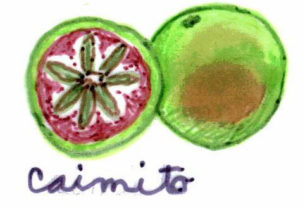Last month’s column discussed buying and storing summer fruit, as well as the versatile fruit salsas which are perfect for outdoor dining. This month some ideas for using fruit as part of the main course are given.
Here in Mexico, especially in the southern coastal regions, fruit is much more than a salad course or garnish. In many parts of the country, regional cooking would be unthinkable without it. Mexicans have a healthy appreciation for the flavor and benefits of fruit, and put it to culinary uses ranging from rustic to highly sophisticated. Mangos, guavas, pineapples and plantains are just a few of the tropical fruits incorporated into traditional Mexican dishes; apples, peaches, pears, apricots and other fruit from the cooler highland regions, introduced by the Spaniards, are used as well.
Long before the arrival of the Europeans, however, the indigenious population took great pleasure in the taste and texture of the native fruit. The Aztecs, in particular, were avid consumers of fruit and had a wide vocabulary of words to describe the various tastes, textures and stages of ripeness. Between the two major categories – tzapotl, or sweet fruit, and xocotl, sour fruit – there was an enormous range of words to describe every quality fruit can possibly have, from mouth-puckering to overripe.
Those two Nahuatl words are still part of the Mexican vocabulary. Zapote, from tzapotl, is a delightfully sweet, perfumed fruit found in great abundance in Veracruz, where a hit on the head from one of these beauties falling from a tree is called a zapotazo. Xocotl is alive and well in the form of xoconostle, the sour cooking variety of cactus fruit that is used in such indigenous dishes as caldo de charral, a fish broth from the Lake Patzcuaro region of Michoacan, and mixiotes de nopales from the Sierra region of Puebla. These dishes are wonderful examples of the purely indigenous cooking, still found in certain parts of the country, which reflects the creative use of fruit by the pre-Hispanic people of Mexico.
While the Aztecs relied heavily on the nopal cactus fruit, called tuna by the Spaniards, the Maya and other coastal people had a variety of tropical fruit, and the earliest Spanish explorers tell us that Maya communities always had well-cultivated fruit orchards. Zapote, pineapple and papaya were among the tributes first offered by the Maya to the Europeans as gifts of welcome. Juan Diaz, the chaplain on Grijalva’s 1518 Yucatan expedition, describes fruit found on the island of Cozumel as “peaches weighing three pounds each”, which historians have suggested could possibly refer to papaya or mamey.
With the conquest came even more fruit. Figs, grapes, dates and plums, as well as the Asian citrus fruits such as Seville oranges, brought to Spain by the Moors, all were imported for cultivation in the New World and found their way to creole tables. Dishes such as manchamanteles, the Puebla chicken and fruit stew which is a direct descendent of medieval Spanish cooking, with the significant Mexican addition of chiles and plantains, were forerunners of nouvelle Mexican cuisine specialties such as pork tenderloins with guava sauce.
The marriage of fruit with meat, fish and fowl, which has spanned Mexican history from pre-Hispanic times to the Conquest to la nueva cocina, has proven to be a long-lasting and happy one.
The following recipes are only a sampling, from various parts of the country, of the delicious offspring that this culinary union has produced.
- Mexican chicken and fruit stew: Manchamanteles
- Mexican pork tenderloins with guavas: Escalopas de cerdo con guayabas
- Mexican steamed carrots with vanilla: Zanahorias al vapor con vainilla
- Red snapper with Mexican mango sauce: Huachinango con salsa de mango


